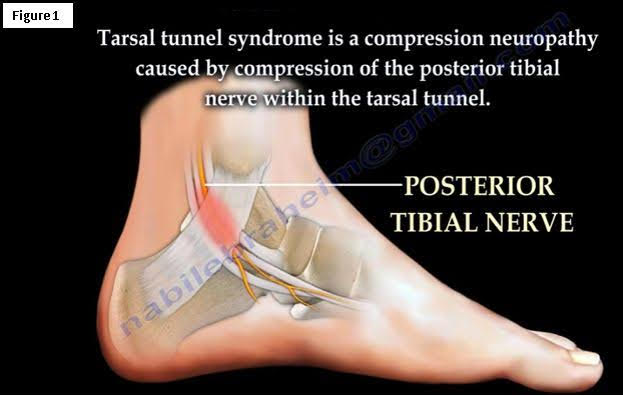What is it?
The tibial nerve (or one if its branches – the medial or lateral plantar nerves) is compressed in the tarsal tunnel. The tarsal tunnel is on the inside of ankle, under the bony prominence of the ankle and is covered by a thick and fibrosis band that helps keeps the contents in place. The tunnel contains an artery/vein and tendons, as well as the nerve.
The tibial nerve and its branches give you sensation to the underside of your foot as well as supply some of the small muscles. This means that if the nerve is compressed, as it is with tarsal tunnel syndrome (TTS) you can get pain, numbness or tingling on the underside of foot and in some cases weakness in the foot. Where you get the symptoms depends on where the nerve is compressed within the tunnel.
How does it get injured?
There are numerous causes of tarsal TTS. They can divided into intrinsic and extrinsic. A few examples of an intrinsic cause is if there is a tumour, swelling, changes to the tibial vein or a ganglion cyst within the tunnel.
Examples of extrinsic include pressure from casts, poor fitting shoes, diabetes, arthritis or if the heel is angled inwards/outwards (heel varus/valgus).
How is it diagnosed?
Your health care professional will ask you multiple questions on your symptoms and it’s relevant history to build up clear picture. They will then look at your foot posture, ankle/foot range of motion, palpate your ankle and foot and assess your strength and sensation. They will do a special test that can indicate if the tibial nerve is involved, by lightly tapping over the tarsal tunnel, which if positive, will reproduce tingling/numbness/pain over the affected area. If necessary they will send you for imaging.
What can Back in Action do to help?
Treatment depends on the cause of TTS.
Your physio may massage your foot/leg in attempt to release any tight muscles that may contribute to the compression. They may also give you some advice on appropriate footwear and/or work through different cues to get your foot in a more optimal position. Taping can also be an option to help optimise foot positioning and offload the tarsal tunnel. Strengthening and stretching exercises may be prescribed as well as an exercise which can help mobilise the tibial nerve to glide through its sheath.

